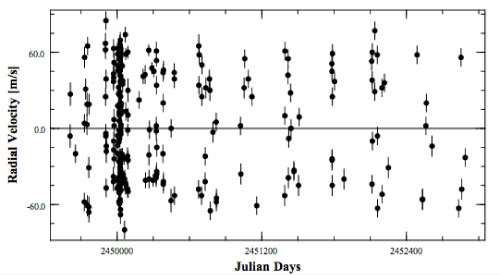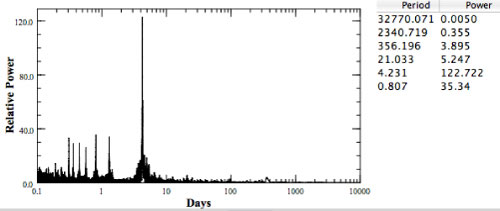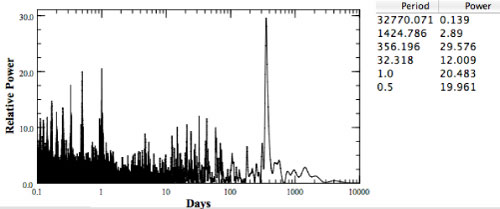Yesterday, we supplied the Systemic Console with the published radial velocity datasets of the the planetary system that started it all, the original gangsta, 51 Peg.

It’s interesting, after more than a decade of observation, to see what happens as a radial velocity time series acquires a long baseline. Launch the Systemic Console, and select 51 Peg from the system menu. You’ll see a plot that looks like this:

With the “51peg_1.vels” offset slider, it’s easy to separate the two contributing data sets. (One was published by the California-Carnegie Planet Search Team, the other by the Geneva Extrasolar Planet Survey). The Swiss data set gives a long baseline of coverage, whereas the California-Carnegie dataset contains intensive observations taken mostly over the course of a single observing season in 1996. Click on the periodogram, and be patient while the console works through the Lomb-Scargle algorithm. While you’re waiting, you can look eagerly forward to the fact that in Aaron Wolf’s next release of the console (due in a few weeks) the periodogram calculation will be sped up by more than a factor of ten.

The periodogram has an impressive tower of power at 4.231 days. This dataset contains a whopping-strong sinusoidal signal:
To work up 51 Peg “b”, activate the first row of planetary orbital element sliders and type 4.231 into the period box. Then (1) line-minimize the mean anomaly, (2) line-minimize the mass, (3,4) line-minimize both offset sliders, and (5) line-minimize the period. (6) Activate a small eccentricity, (7) move the longitude of periastron slider off the zero point, and then (8) click the Levenberg-Marquardt boxes to the left of each entry box and polish the fit. (If this sounds like gibberish, yet also exciting, we’ve written three tutorials [here, here, and here] that go into detail regarding the use of the console. In addition, all posts marked “systemic faq” contain information about how to use and work with the console.)
When I do this, the console gives me a single planet fit with P=4.2308 days, M=0.4749 Jupiter Masses, and eccentricity e=0.014. These values are in full agreement with the orbital parameters published in the original discovery paper.
Alert readers are likely grumbling that we’ve made no mention of uncertainties in the orbital elements. This is an extremely important and interesting issue for many systems, and we’ll definitely be posting extensively on the topic and theory of computation of errors in orbital elements of extrasolar planets. The entire Systemic research collaboration, in fact, is primarily concerned with resolving the issue of how to establish confidence levels in various types of planetary system configurations.
In the meantime, however, use the console to compute a periodogram of the velocity residuals to the old-school 1-planet fit. A strong peak stands out at a period of 356.196 days. The chi-square statistic of the 1-planet fit is just over 2.00, and the required stellar jitter is about 7 meters per second. This is significantly higher than the 3-5 meters per second of long-term jitter that is expected for a quiet, old G2 IV star like 51 Peg:

Could there be another planet in the system? Could it be, that the console, by virtue of the fact that it readily combines data sets from different published sources, has found a new world (in a habitable orbit no less)? Tune in tomorrow to find out…

Pingback: systemic - 51 Peg c
Pingback: systemic - Some evidence for the existence of 51 Peg c